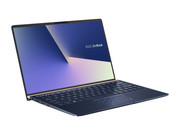Asus ZenBook 13 UX333FN-A3064T
Specifications

Price comparison
Average of 5 scores (from 9 reviews)
Reviews for the Asus ZenBook 13 UX333FN-A3064T
Source: Lowyat.net
 Archive.org version
Archive.org versionThe ASUS ZenBook 13 is a laptop that I like a lot, even if its size is not exactly right for me. It does many things right, and I suspect had I reviewed the ZenBook 14 instead, this would’ve been a much shorter review. In fact, about half of the issues I have with it has to do with its size.
Single Review, online available, Long, Date: 06/22/2019
Source: Gadgets Now
 Archive.org version
Archive.org versionNonetheless, it is a great device and if you want a heavy duty laptop that you can whip out while on the go, buy it. This new ZenBook 13 can work its way through any t ..
Single Review, online available, Short, Date: 03/07/2019
Rating: Total score: 70%
Source: Hitech Century
 Archive.org version
Archive.org versionThe ZenBook 13 UX333 is one of the smallest and most powerful notebooks in its class with beautiful design, a great display and an excellent keyboard with several novel enhancements that aim to maximise utility like its overlaid numeric touchpad. Add in its ultra compact form factor and you have a winner.
Single Review, online available, Medium, Date: 01/12/2019
Rating: Total score: 82% price: 60% performance: 90% display: 80% mobility: 70% workmanship: 80%
Source: Ultrabook Review
 Archive.org version
Archive.org versionI can’t draw final conclusions on this Core i7 / MX150 configuration of the ZenBook UX333FN based on our sample, because the gaming performance is crucial in the whole equation and I can’t tell whether the final retail units will perform similarly to our test model or perhaps better. I can tell you that the performance is there, but whether or not it can last for longer gaming sessions remains to be elucidated in our future updates, once we hopefully get our hands on a final retail product. Till then, take our findings with a lump of salt.
Single Review, online available, Very Long, Date: 11/23/2018
Rating: Total score: 80%
Foreign Reviews
Source: 15 Zoll Notebooks Test
 DE→EN Archive.org version
DE→EN Archive.org versionSingle Review, online available, Medium, Date: 05/14/2019
Rating: Total score: 86% price: 84% performance: 86% features: 87% mobility: 86%
Source: HDblog.it
 IT→EN Archive.org version
IT→EN Archive.org versionPositive: Elegant design; compact size; solid workmanship; good cooling and silent system; decent hardware; attractive price. Negative: Many bloatwares; uncomfortable keyboard.
Single Review, online available, Long, Date: 04/11/2019
Source: Nghenhin Vietnam
 VN→EN Archive.org version
VN→EN Archive.org versionPositive: Compact size; light weight; powerful hardware; nice performance; attractive price.
Single Review, online available, Medium, Date: 03/07/2019
Source: Nghenhin Vietnam
 VN→EN Archive.org version
VN→EN Archive.org versionPositive: Compact size; light weight; powerful hardware; stylish design; good price.
Single Review, online available, Medium, Date: 12/12/2018
Source: Lyd og Billede
 DA→EN Archive.org version
DA→EN Archive.org versionSingle Review, online available, Short, Date: 05/20/2019
Rating: Total score: 67%
Comment
NVIDIA GeForce MX150: Pascal GP108 based laptop graphics card and mobile version of the desktop GeForce GT 1030. Offers 384 shader cores and usually 2 GB GDDR5 with a 64 Bit memory bus. Manufactured in 14nm.
Modern games should be playable with these graphics cards at low settings and resolutions. Casual gamers may be happy with these cards.
» Further information can be found in our Comparison of Mobile Graphics Cards and the corresponding Benchmark List.
Intel Core i7: The Intel Core i7 for laptops is based on the LG1156 Core i5/i7 CPU for desktops. The base clock speed of the CPUs is relatively low, but because of a huge Turbo mode, the cores can dynamically overclock to up to 3.2 GHz (920XM). Therefore, the CPU can be as fast as high clocked dual-core CPUs (using single threaded applications) but still offer the advantage of 4 cores. Because of the large TDP of 45 W / 55 W, the CPU is only intended for large laptops.
i7-8565U: Whiskey Lake based low power quad-core processor (technically identical to Kaby Lake but produced in a further improved 14nm++ process). The four cores are clocked between 1.8 and 4.6 GHz (Turbo Boost) and support HyperThreading.» Further information can be found in our Comparison of Mobile Processsors.




